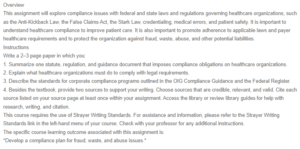Healthcare Compliance
Compliance statutes, regulations, and guidance document
The Anti-Kickback Statute is a law in the healthcare setting. It forbids people and organizations from paying compensation or giving anything of value in exchange for patient referrals that result in payments from federal healthcare programs (Szalados, 2021). This law is crucial because inappropriate monetary rewards can result in poor medical judgment, greater Medicare and Medicaid services costs, and other adverse outcomes.
Health Insurance Portability and Accountability Act (HIPAA) protects information about healthcare systems. The law applies to all healthcare givers. It covers all patient information verbally, on paper, or through electronic media. HIPAA gives patients the right to access their health information. Furthermore, it gives them the right to decide who can access the information and how it can be used.
The Office of the Inspector General (OIG) has established compliance documents for various healthcare industry divisions. One of the documents is for the Pharmaceutical manufacturers. The document describes the OIG’s thoughts and views on the importance and basic tenets of pharmaceutical producer compliance programs and the specific components that pharmaceutical manufacturers should consider when creating and executing a successful compliance program.
We are complying with legal requirements.
All healthcare organizations must have a compliance program. All members of the organization must participate in the health compliance program. This means that all members understand that all their activities affect general healthcare compliance (Mattie et al., 2021). Moreover, they should endeavor to follow all laws and regulations daily. When errors occur, healthcare organizations with a compliance program learn from their mistakes. They aim to investigate the core cause and implement efforts to prevent such errors from happening again. Developing a culture of healthcare compliance takes time. Getting it right demands effort, education, and several trial-and-error phases—additionally, a compliance officer and a department devoted to healthcare compliance aid in complying with legal requirements. Executive leadership support is also needed. Leaders set the example and promote moral conduct from the executive level.
Standards for corporate compliance programs
Firstly, they create compliance laws and programs, including standards of conduct. These express the business’ dedication to compliance. It also addresses certain instances of potential fraud and abuse, like the techniques used in sales and marketing and in providing pricing and reimbursement information to government healthcare programs. The OIG advises that compliance laws and programs be created in a way that aids personnel in maintaining compliance while doing their job duties.
Secondly, the appointment of a compliance officer and a compliance committee. The OIG recommends that a competent compliance officer should lead the compliance program. Skilled committee members can assist the officer. This team will develop, operate, and monitor the compliance program. Their findings and progress will be reported to the president or the board of directors.
Thirdly, suitable education and instruction. Regular and practical educational sessions on compliance should be provided for all members affected by compliance laws. Not adequately trained and educated staff run the danger of breaking compliance statutes and regulations.
Fourthly, internal surveillance and evaluation. Implementing audits and other risk assessment methods to monitor compliance, pinpoint areas of concern, and help counter those problem areas.
Fifthly, open channels of communication. Open communication should exist between the compliance officer and the employees. There should be a way of asking questions or receiving a complaint. There should be ways of reporting fraud or abuse. Additionally, the program should implement mechanisms to protect informers’ safety and the confidentiality of complainants.
They are lastly, creating policies and practices for investigating suspected misbehavior or non-compliance cases. These should contain instructions on how to react promptly and appropriately to infractions when they are discovered, including how to start the requisite corrective measures and preventive practices and how to report the offense to the appropriate authorities when the time is right.
References
Mattie, A. S., Charlier, S. D., West, S., & Runyan, J. D. (2020). Educating healthcare compliance professionals: Identification of competencies. Journal of Education for Business, 95(6), 367-374. https://doi.org/10.1080/08832323.2019.1664375
Szalados, J. E. (2021). Regulations and Regulatory Compliance: False Claims Act, Kickback and Stark Laws, and HIPAA. In The Medical-Legal Aspects of Acute Care Medicine (pp. 277-313). Springer, Cham. https://doi.org/10.1007/978-3-030-68570-6_12
ORDER A PLAGIARISM-FREE PAPER HERE
We’ll write everything from scratch
Question

Healthcare Compliance
Overview
This assignment will explore compliance issues with federal and state laws and regulations governing healthcare organizations, such as the Anti-Kickback Law, the False Claims Act, the Stark Law, credentialing, medical errors, and patient safety. It is important to understand healthcare compliance to improve patient care. It is also important to promote adherence to applicable laws and payer healthcare requirements and to protect the organization against fraud, waste, abuse, and other potential liabilities.
Instructions
Write a 2–3 page paper in which you:
1. Summarize one statute, regulation, and guidance document that imposes compliance obligations on healthcare organizations.
2. Explain what healthcare organizations must do to comply with legal requirements.
3. Describe the standards for corporate compliance programs outlined in the OIG Compliance Guidance and the Federal Register.
4. Besides the textbook, provide two sources to support your writing. Choose sources that are credible, relevant, and valid. Cite each source listed on your source page at least once within your assignment. Access the library or review library guides for help with research, writing, and citation.
This course requires the use of Strayer Writing Standards. For assistance and information, please refer to the Strayer Writing Standards link in the left-hand menu of your course. Check with your professor for any additional instructions.
The specific course learning outcome associated with this assignment is:
*Develop a compliance plan for fraud, waste, and abuse issues.*


